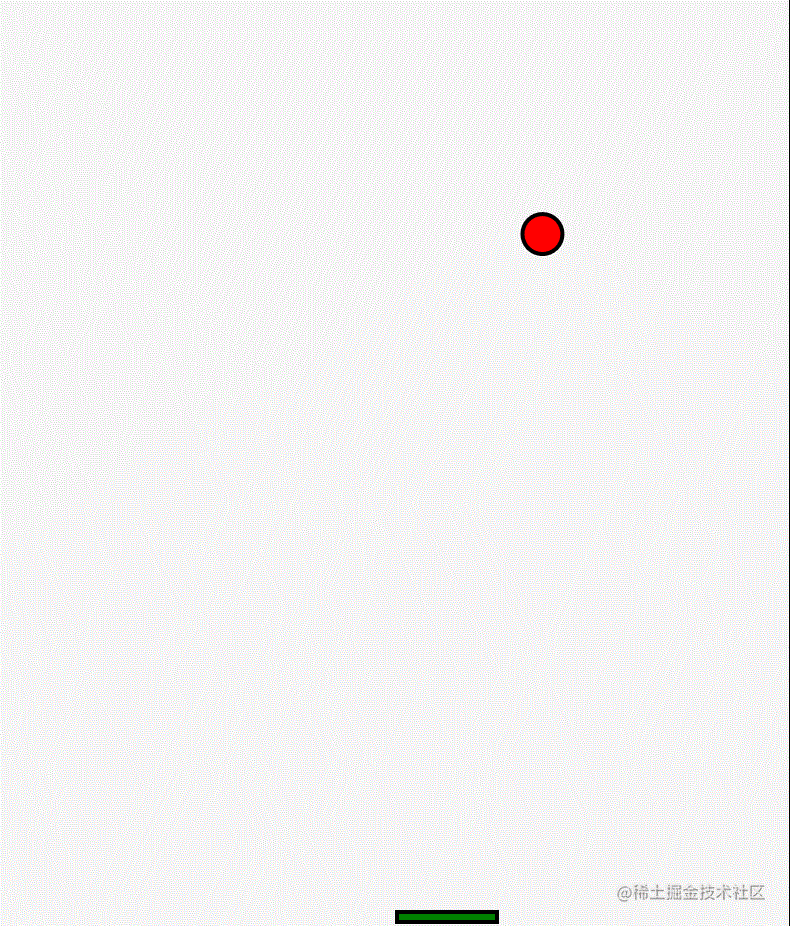使用konvajs三步实现一个小球游戏
记得以前玩过一个很简单的小游戏,一个球在动,然后底下一个板来接,如果没接住撞到底边游戏就结束了,虽然忘了它叫什么名字,但一直心心念念,魂牵梦萦,刚好最近临过年需求不饱和、刚好之前一直想做但是没动手,刚好这两天在学习konvajs,刚好就有了这篇小文章,很简单,只要三步,包你三分钟学会。
konvajs简介
konvajs就像jquery之于DOM、Snap.svg之与svg一样之于canvas,可以方便的实现canvas的图形交互效果,使用它,你可以快速绘制常用图形,并能方便的给它添加样式、各种事件、动画效果等等,妈妈再也不用担心我自己来检测鼠标位置了。文档:https://konvajs.org/。
使用konvajs基本上也分为三步,第一步是创建一个"舞台":
import { Stage } from 'konva'
const stage = new Stage({
container: 'container',// 容器元素的id
width: 500,
height: 500
})
第二步是创建一个“图层”,添加到“舞台”里:
import { Layer } from 'konva'
const layer = new Layer()
stage.add(layer)
一个layer对应着一个canvas元素。
第三步就是创建各种图形添加到“图层里”。
第一步
来一个小球和挡板。
直接复制官方文档上的圆和矩形的示例代码,小球:
import { Circle } from 'konva'
createCircle () {
// 小球的中心坐标
this.centerX = this.stage.width() / 2
this.centerY = 100
this.circle = new Circle({
x: this.centerX,
y: this.centerY,
radius: this.radius,
fill: 'red',
stroke: 'black',
strokeWidth: 4
})
this.layer.add(this.circle)
this.layer.draw()// 重新绘制,每次修改后都需要调用该方法
}
挡板:
import { Rect } from 'konva'
createRect () {
this.rect = new Rect({
x: (this.stage.width() - 100) / 2,
y: this.height - 50,
width: 100,
height: 10,
fill: 'green',
stroke: 'black',
strokeWidth: 4,
draggable: true,// 允许拖动
dragBoundFunc: function (pos) {// 控制只能水平拖动
return {
x: pos.x,
y: this.absolutePosition().y// 获取y的绝对位置
}
}
})
this.layer.add(this.rect)
this.layer.draw()
}

第二步
让球动起来,给球一个初始速度,一个加速度,撞墙后速度反向,速度逐渐加快,用来增加游戏难度:
this.speedX = Math.random() * 3
this.speedY = Math.random() * 3
this.speedStep = 0.01
runCircle () {
// 修改小球位置
this.centerX += this.speedX
this.centerY += this.speedY
this.circle.x(this.centerX)
this.circle.y(this.centerY)
// 撞墙检测
if (this.centerX - this.radius <= 0 || this.centerX + this.radius >= this.width) {// 左侧和右侧的墙
this.speedX = -this.speedX// 水平速度反向
}
if (this.centerY - this.radius <= 0) {// 只判断顶部的墙,底部的墙用来结束游戏
this.speedY = -this.speedY
}
// 撞板检测,第三步再说
this.collisionCheck()
// 游戏结束检测
if (this.centerY + this.radius >= this.height) {// 撞到底部的墙游戏就结束了
return this.gameOver()
}
// 加速度
// 还没达到最大速度则增加速度
if (Math.abs(this.speedX) < this.maxSpeed) {
this.speedX > 0 ? this.speedX += this.speedStep : this.speedX -= this.speedStep
}
if (Math.abs(this.speedY) < this.maxSpeed) {
this.speedY > 0 ? this.speedY += this.speedStep : this.speedY -= this.speedStep
}
}
然后使用requestAnimationFrame来不断刷新:
update () {
window.requestAnimationFrame(() => {
this.runCircle()
this.update()
this.layer.draw()
})
}

第三步
检测小球和挡板的是否碰撞,撞到了则速度反向,原理是找到矩形四周离小球的圆心最近的点,然后判断这个点和小球圆心的距离是否小于小球半径,这个点怎么确定也很简单,如果圆心在矩形的左侧,那么这个点一定在矩形的左侧边上,点x的值也就是rect.x,如果在矩形的右侧,点x的值一定在矩形的右侧边上,也就是rect.x + rect.width,如果在矩形之间的话,因为最近的点和圆心的连线肯定是重置于矩形的边,所以点x的值就是圆心的x,点y的计算和x一样。

collisionCheck () {
let minx = 0
let miny = 0
let rectX = this.rect.x()
let rectY = this.rect.y()
let rectWidth = this.rect.width()
let rectHeight = this.rect.height()
// 确定矩形上离小球最近的点的x坐标
if (this.centerX < rectX) {// 在矩形左侧
minx = rectX
} else if (this.centerX > rectX + rectWidth) {// 在矩形右侧
minx = rectX + rectWidth
} else {// 在矩形左右之间
minx = this.centerX
}
// 确定矩形上离小球最近的点的y坐标
if (this.centerY < rectY) {// 在矩形上面
miny = rectY
} else if (this.centerY > rectY + rectHeight) {// 在矩形下面
miny = rectY + rectHeight
} else {// 在矩形上下之间
miny = this.centerY
}
// 如果距离小于半径则代表发生了碰撞
if (this.getTwoPointDistance(minx, miny, this.centerX, this.centerY) <= this.radius) {
// 撞到了左侧或右侧,那么水平速度x反向
if (minx === rectX || minx === rectX + rectWidth) {
this.speedX = -this.speedX
}
// 撞到了矩形上面则垂直速度y反向
if (miny === rectY) {
this.speedY = -this.speedY
}
}
}
到这里就结束了,可以愉快的开玩了:

- 点赞
- 收藏
- 关注作者


评论(0)